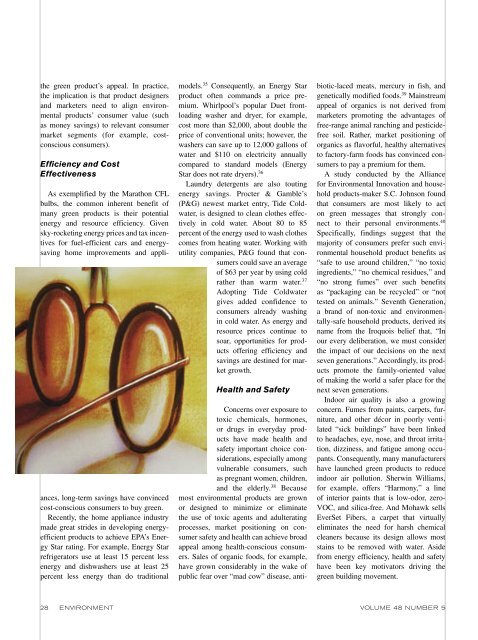Avoiding Green Marketing Myopia - J. Ottman Consulting
Avoiding Green Marketing Myopia - J. Ottman Consulting
Avoiding Green Marketing Myopia - J. Ottman Consulting
Create successful ePaper yourself
Turn your PDF publications into a flip-book with our unique Google optimized e-Paper software.
the green product’s appeal. In practice,<br />
the implication is that product designers<br />
and marketers need to align environmental<br />
products’ consumer value (such<br />
as money savings) to relevant consumer<br />
market segments (for example, cost-<br />
conscious consumers).<br />
Efficiency and Cost<br />
Effectiveness<br />
As exemplified by the Marathon CFL<br />
bulbs, the common inherent benefit of<br />
many green products is their potential<br />
energy and resource efficiency. Given<br />
sky-rocketing energy prices and tax incentives<br />
for fuel-efficient cars and energy-<br />
saving home improvements and appli-<br />
ances, long-term savings have convinced<br />
cost-conscious consumers to buy green.<br />
Recently, the home appliance industry<br />
made great strides in developing energy-<br />
efficient products to achieve EPA’s Energy<br />
Star rating. For example, Energy Star<br />
refrigerators use at least 15 percent less<br />
energy and dishwashers use at least 25<br />
percent less energy than do traditional<br />
models. 35 Consequently, an Energy Star<br />
product often commands a price premium.<br />
Whirlpool’s popular Duet frontloading<br />
washer and dryer, for example,<br />
cost more than $2,000, about double the<br />
price of conventional units; however, the<br />
washers can save up to 12,000 gallons of<br />
water and $110 on electricity annually<br />
compared to standard models (Energy<br />
Star does not rate dryers). 36<br />
Laundry detergents are also touting<br />
energy savings. Procter & Gamble’s<br />
(P&G) newest market entry, Tide Coldwater,<br />
is designed to clean clothes effectively<br />
in cold water. About 80 to 85<br />
percent of the energy used to wash clothes<br />
comes from heating water. Working with<br />
utility companies, P&G found that consumers<br />
could save an average<br />
of $63 per year by using cold<br />
rather than warm water. 37<br />
Adopting Tide Coldwater<br />
gives added confidence to<br />
consumers already washing<br />
in cold water. As energy and<br />
resource prices continue to<br />
soar, opportunities for products<br />
offering efficiency and<br />
savings are destined for market<br />
growth.<br />
Health and Safety<br />
Concerns over exposure to<br />
toxic chemicals, hormones,<br />
or drugs in everyday products<br />
have made health and<br />
safety important choice considerations,<br />
especially among<br />
vulnerable consumers, such<br />
as pregnant women, children,<br />
and the elderly. 38 Because<br />
most environmental products are grown<br />
or designed to minimize or eliminate<br />
the use of toxic agents and adulterating<br />
processes, market positioning on consumer<br />
safety and health can achieve broad<br />
appeal among health-conscious consumers.<br />
Sales of organic foods, for example,<br />
have grown considerably in the wake of<br />
public fear over “mad cow” disease, anti-<br />
biotic-laced meats, mercury in fish, and<br />
genetically modified foods. 39 Mainstream<br />
appeal of organics is not derived from<br />
marketers promoting the advantages of<br />
free-range animal ranching and pesticidefree<br />
soil. Rather, market positioning of<br />
organics as flavorful, healthy alternatives<br />
to factory-farm foods has convinced consumers<br />
to pay a premium for them.<br />
A study conducted by the Alliance<br />
for Environmental Innovation and household<br />
products-maker S.C. Johnson found<br />
that consumers are most likely to act<br />
on green messages that strongly connect<br />
to their personal environments. 40<br />
Specifically, findings suggest that the<br />
majority of consumers prefer such environmental<br />
household product benefits as<br />
“safe to use around children,” “no toxic<br />
ingredients,” “no chemical residues,” and<br />
“no strong fumes” over such benefits<br />
as “packaging can be recycled” or “not<br />
tested on animals.” Seventh Generation,<br />
a brand of non-toxic and environmentally-safe<br />
household products, derived its<br />
name from the Iroquois belief that, “In<br />
our every deliberation, we must consider<br />
the impact of our decisions on the next<br />
seven generations.” Accordingly, its products<br />
promote the family-oriented value<br />
of making the world a safer place for the<br />
next seven generations.<br />
Indoor air quality is also a growing<br />
concern. Fumes from paints, carpets, furniture,<br />
and other décor in poorly ventilated<br />
“sick buildings” have been linked<br />
to headaches, eye, nose, and throat irritation,<br />
dizziness, and fatigue among occupants.<br />
Consequently, many manufacturers<br />
have launched green products to reduce<br />
indoor air pollution. Sherwin Williams,<br />
for example, offers “Harmony,” a line<br />
of interior paints that is low-odor, zero-<br />
VOC, and silica-free. And Mohawk sells<br />
EverSet Fibers, a carpet that virtually<br />
eliminates the need for harsh chemical<br />
cleaners because its design allows most<br />
stains to be removed with water. Aside<br />
from energy efficiency, health and safety<br />
have been key motivators driving the<br />
green building movement.<br />
28 ENVIRONMENT VOLUME 48 NUMBER 5


